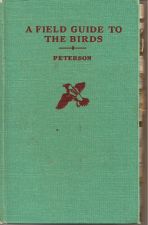 I tried to switch – and couldn’t.
I tried to switch – and couldn’t.
A birder’s field guide is a highly personal, well worn tool that fits the individual’s needs – at least for a while. Last month I tried again to find a guide for my changing needs but my quest failed. I still prefer my old favorite.
A hundred years ago there were no pocket-sized books of bird pictures to carry into the field. Birders had to memorize what they saw and look it up later. Then in 1934 Roger Tory Peterson published his famous Field Guide to the Birds and everything changed.
My first field guide was Petersen’s 1963 edition, shown at left. Most of the pictures were in black and white and all of them were grouped on plates. I marked the plates with tabs made of white bandage tape so I could find them easily. I rarely read the text.
The order of the pictures was mysterious to me. Birds were presented in taxonomic order, the order in which they were supposed to have evolved. This placed loons and ocean birds first in the book, finches and sparrows last. I still find the order annoying but I’ve memorized it – or rather, I had memorized it – which is part of what went wrong when I tried to switch guides recently.
My current and continuing favorite is Ken Kaufman’s Birds of North America. The book covers the entire continent north of Mexico, an absolute “must” for my field guide. Kaufman uses retouched photos instead of drawings to display the birds. In retouching the photos he removed the distracting background and enhanced the birds’ notable features. I prefer the pictures to most other guides’ drawings.
The drawbacks of the Kaufman guide are that he groups birds together by similarity, not in taxonomic order, and the edition I use does not have comparison plates of ducks and shorebirds in flight. I am weak on shorebirds so I looked for a replacement guide.
This proved elusive because I made an impulse buy rather than doing a serious comparison of existing guides. I didn’t even look at a new edition of Kaufman’s. I bought a National Geographic guide on sale and began to transcribe my sightings from the old guide to the new.
Yes, I write in my field guide. Next to the bird’s description I note the location and date of the first time I ever saw it. I also record notable sightings at other locations and times of year so I can scan the book for places I’m likely to find migrants. It’s like a Life List but more useful.
Transcribing was fun but it was the beginning of my doubt about changing field guides. As I transcribed, I saw the pictures I love. Kaufman’s Lewis’s Woodpecker in flight looks exactly like the bird we saw at the Allegheny Front Hawk Watch in October 2002. How could I trade that photo for the drawing?
Then, when transcribing was only halfway done, I decided to try the new book in the field. At Moraine State Park I used it on distant ducks. That’s when I realized that the Kaufman guide had made me forget taxonomic order. And National Geographic’s quick index was in a smaller font (not good for my older eyes) and didn’t include as many species. And the drawings of familiar ducks looked so different that I studied the guide instead of the ducks in front of me. Ack! I was flummoxed.
Enough. I photocopied Petersen’s pages of ducks and shorebirds in flight and stuck them in my Kaufman guide. I am back to where I started – and happier.